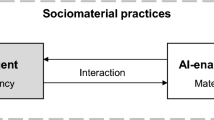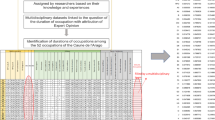Abstract
This paper has the goal to describe the introduction of an AGI (Artificial General Intelligence) in a human organization. An organization may be composed of project leaders (vertical communication), human and non-human operations, an AGI machine that manages horizontal communication and big data. This leads to the paradigm of the Organizational Great Machine (GM) in which humans benefit from upgrade or empowerment provided by an all-encompassing artificial intelligence. An AGI has a substrate that uses Multi Agent System (MAS) where the model of an agent is defined as a belief, desire, intention (BDI) model of an agent augmented with Situations and Action (SBDIA). This provides a way of explaining future-directed intention. SBDIA has a natural model consistent with human psychology. Once artificial intelligence is introduced into the organization, we have to design new Human-Machine Integration (HMI) tools to have a successful relationship with human resources. At the end the organizational model of the MAS, called Great machine (GM), is used to provide information and transparency about the behavior of an AGI. A GM's internal model is considered as a knowledge market where knowledge flows among agents. Leontief's economic model emulates this market by providing information on how knowledge flows and how it is used. This permits more transparency and an understanding of internal processes.
Access this chapter
Tax calculation will be finalised at checkout
Purchases are for personal use only
Similar content being viewed by others
References
Systems Engineering Guide for Systems of Systems, Version 1.0 (2008)
Bratman, M.E.: Intention, Plans, and Practical Reason. CSLI Publications. ISBN 1-57586-192-5 (2006)
Bratman, M.E.: Faces of Intention. Cambridge University Press. ISBN 0521631319. 978-0–521-63131-0
Rago, F.: Sentient Theory , Sentient basic agent Design_PL_REFKB_V0.2, under review
Thielscher, M.: Introduction to the fluent calculus. Electron. Trans. Artif. Intell. (1998)
Thielscher, M.: Reasoning robots - the art and science of programming robotic agents. In: Volume 33 of Applied Logic Series. Springer, Dordrecht (2005). https://doi.org/10.1007/1-4020-3069-X
Leontief, W.W.: Input-Output Economics. Oxford University Press, New York (1966)
Dietzenbacher, E., Lahr, M.L. (eds.): Wassily Leontief and Input-Output Economics. Cambridge University Press (2004). https://doi.org/10.1017/CBO9780511493522
Yamaguchi, H.: A cooperative hunting behavior by mobile-robot troops. The International Journal of Robotics Research 18(8), 931–940 (1999)
Gazi, V., Passino, K.M.: Stability analysis of swarms. IEEE Trans. Autom. Control 48(4), 692–697 (2003)
Jorgenson, D.W.: Growth: Econometric General Equilibrium Modeling. The MIT Press (1998)
Rao, A.S., Georgeff, M.P.: Modeling rational agents within a BDI-architecture. In: Proceedings of the 2nd International Conference on Principles of Knowledge Representation and Reasoning, pp. 473–484 (1991)
Rao, A.S. Georgeff, M.P.: BDI-agents: from theory to practice. In: Proceedings of the First International Conference on Multi-agent Systems (ICMAS 1995), San Francisco (1995)
Bratman, M.E.: Intention, Plans, and Practical Reason. CSLI Publications (1987)
Li, S.E., et al.: Dynamical modeling and distributed control of connected and automated vehicles: challenges and opportunities. IEEE Intell. Transp. Syst. Mag. 9(3), 46–58 (2017)
Bouzid, M., Ligeza, A.: Temporal causal networks for simulation and diagnosis, publisher. In: Proceedings of ICECCS 1996: 2nd IEEE International Conference on Engineering of Complex Computer Systems (1996)
Author information
Authors and Affiliations
Corresponding author
Editor information
Editors and Affiliations
Rights and permissions
Copyright information
© 2022 The Author(s), under exclusive license to Springer Nature Switzerland AG
About this paper
Cite this paper
Rago, F. (2022). A New Matrix Model for Human-AI Integration. In: Arai, K. (eds) Proceedings of the Future Technologies Conference (FTC) 2021, Volume 1. FTC 2021. Lecture Notes in Networks and Systems, vol 358. Springer, Cham. https://doi.org/10.1007/978-3-030-89906-6_9
Download citation
DOI: https://doi.org/10.1007/978-3-030-89906-6_9
Published:
Publisher Name: Springer, Cham
Print ISBN: 978-3-030-89905-9
Online ISBN: 978-3-030-89906-6
eBook Packages: Intelligent Technologies and RoboticsIntelligent Technologies and Robotics (R0)




